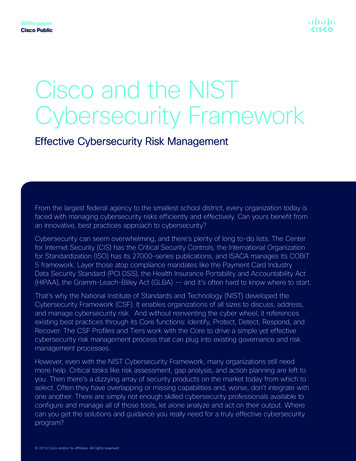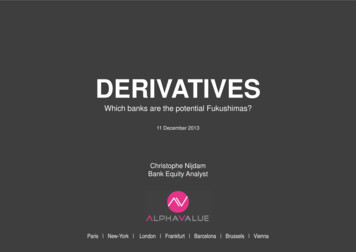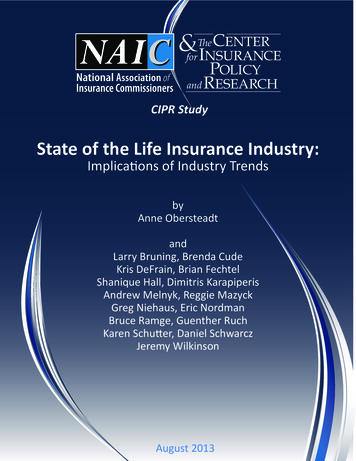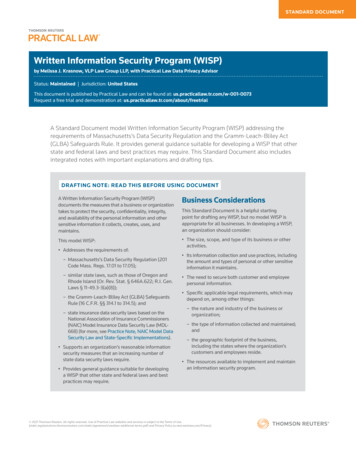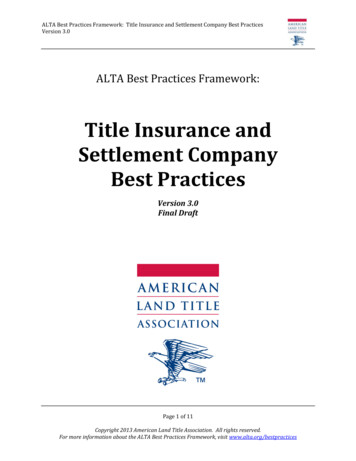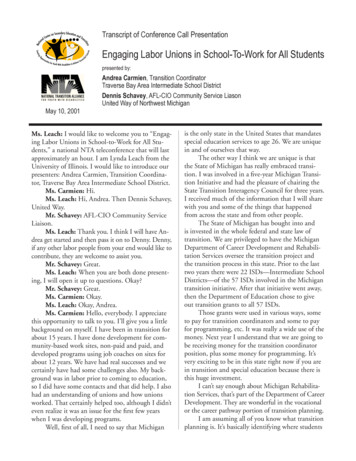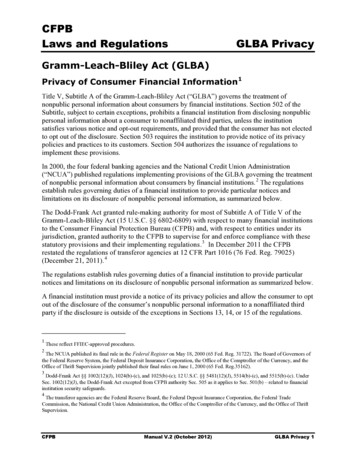
Transcription
Gramm-Leach-Bliley Act (GLBA)Privacy of Consumer Financial Information 1Title V, Subtitle A of the Gramm-Leach-Bliley Act (“GLBA”) governs the treatment ofnonpublic personal information about consumers by financial institutions. Section 502 of theSubtitle, subject to certain exceptions, prohibits a financial institution from disclosing nonpublicpersonal information about a consumer to nonaffiliated third parties, unless the institutionsatisfies various notice and opt-out requirements, and provided that the consumer has not electedto opt out of the disclosure. Section 503 requires the institution to provide notice of its privacypolicies and practices to its customers. Section 504 authorizes the issuance of regulations toimplement these provisions.In 2000, the four federal banking agencies and the National Credit Union Administration(“NCUA”) published regulations implementing provisions of the GLBA governing the treatmentof nonpublic personal information about consumers by financial institutions. 2 The regulationsestablish rules governing duties of a financial institution to provide particular notices andlimitations on its disclosure of nonpublic personal information, as summarized below.The Dodd-Frank Act granted rule-making authority for most of Subtitle A of Title V of theGramm-Leach-Bliley Act (15 U.S.C. §§ 6802-6809) with respect to many financial institutionsto the Consumer Financial Protection Bureau (CFPB) and, with respect to entities under itsjurisdiction, granted authority to the CFPB to supervise for and enforce compliance with thesestatutory provisions and their implementing regulations. 3 In December 2011 the CFPBrestated the regulations of transferor agencies at 12 CFR Part 1016 (76 Fed. Reg. 79025)(December 21, 2011). 4The regulations establish rules governing duties of a financial institution to provide particularnotices and limitations on its disclosure of nonpublic personal information as summarized below.A financial institution must provide a notice of its privacy policies and allow the consumer to optout of the disclosure of the consumer’s nonpublic personal information to a nonaffiliated thirdparty if the disclosure is outside of the exceptions in Sections 13, 14, or 15 of the regulations.1These reflect FFIEC-approved procedures.2The NCUA published its final rule in the Federal Register on May 18, 2000 (65 Fed. Reg. 31722). The Board of Governors ofthe Federal Reserve System, the Federal Deposit Insurance Corporation, the Office of the Comptroller of the Currency, and theOffice of Thrift Supervision jointly published their final rules on June 1, 2000 (65 Fed. Reg.35162).3Dodd-Frank Act §§ 1002(12)(J), 1024(b)-(c), and 1025(b)-(c); 12 U.S.C. §§ 5481(12)(J), 5514(b)-(c), and 5515(b)-(c). UnderSec. 1002(12)(J), the Dodd-Frank Act excepted from CFPB authority Sec. 505 as it applies to Sec. 501(b) – related to financialinstitution security safeguards.4The transferor agencies are the Federal Reserve Board, the Federal Deposit Insurance Corporation, the Federal TradeCommission, the National Credit Union Administration, the Office of the Comptroller of the Currency, and the Office of ThriftSupervision.
Regardless of whether a financial institution shares nonpublic personal information, theinstitution must provide notices of its privacy policies to its customers.A financial institution generally may not disclose customer account numbers to any nonaffiliatedthird party for marketing purposes.A financial institution must follow reuse and redisclosure limitations on any nonpublic personalinformation it receives from a nonaffiliated financial institution.In general, the privacy notice must describe a financial institution’s policies and practices withrespect to disclosing nonpublic personal information about a consumer to both affiliated andnonaffiliated third parties. Also, the notice must provide a consumer a reasonable opportunity todirect the institution generally not to share nonpublic personal information about the consumer(that is, to ‘‘opt out’’) with nonaffiliated third parties other than as permitted by the statute (forexample, sharing for everyday business purposes, such as processing transactions andmaintaining customers’ accounts, and in response to properly executed governmental requests).The privacy notice must also provide, where applicable under the Fair Credit Reporting Act(“FCRA”), a notice and an opportunity for a consumer to opt out of certain information sharingamong affiliates.Section 728 of the Financial Services Regulatory Relief Act of 2006 (“Regulatory Relief Act” or“Act”) required the Agencies to develop a model privacy form that financial institutions may relyon as a safe harbor to provide disclosures under the privacy rules.On December 1, 2009, the four federal banking agencies and four additional federal regulatoryagencies 5 jointly released a voluntary model privacy notice form designed to make it easier forconsumers to understand how financial institutions collect and share nonpublic personalinformation (74 Fed. Reg. 62890). The final rule adopting the model privacy form was effectiveon December 31, 2009, except that notices that were provided on or before December 31, 2010,using sample clauses contained in Appendix B to the 2000 rule continued to receive the safeharbor for compliance with the notice requirements of the regulation for one year. Appendix Band the sample clauses were deleted from the agencies’ rules effective January 1, 2012. 6Definitions and Key ConceptsIn discussing the duties and limitations imposed by the regulations, a number of key concepts areused. These concepts include “financial institution”; “nonpublic personal information”;“nonaffiliated third party”; the “opt-out” right and the exceptions to that right; and “consumer”and “customer.” Each concept is briefly discussed below. A more complete explanation of eachappears in the regulations.5The four additional federal regulators are the NCUA, the Commodity Futures Trading Commission, the Federal TradeCommission, and the Securities and Exchange Commission.6In restating the regulations from transferor agencies, the CFPB removed Appendix B from its regulation.
Financial Institution:A “financial institution” is any institution the business of which is engaging in activities that arefinancial in nature or incidental to such financial activities, as determined by Section 4(k) of theBank Holding Company Act of 1956. Financial institutions can include banks, securities brokersand dealers, insurance underwriters and agents, finance companies, mortgage bankers, and travelagents. 7Nonpublic Personal Information:“Nonpublic personal information” generally is any information that is not publicly available andthat:A consumer provides to a financial institution to obtain a financial product or service fromthe institution;Results from a transaction between the consumer and the institution involving a financialproduct or service; orA financial institution otherwise obtains about a consumer in connection with providing afinancial product or service.Information is publicly available if an institution has a reasonable basis to believe that theinformation is lawfully made available to the general public from government records, widelydistributed media, or legally required disclosures to the general public. Examples includeinformation in a telephone book or a publicly recorded document, such as a mortgage orsecurities filing.Nonpublic personal information may include individual items of information as well as lists ofinformation. For example, nonpublic personal information may include names, addresses, phonenumbers, social security numbers, income, credit score, and information obtained throughInternet collection devices (i.e., cookies).There are special rules regarding lists. Publicly available information would be treated asnonpublic if it were included on a list of consumers derived from nonpublic personalinformation. For example, a list of the names and addresses of a financial institution’s depositorswould be nonpublic personal information even though the names and addresses might bepublished in local telephone directories because the list is derived from the fact that a person hasa deposit account with an institution, which is not publicly available information.However, if the financial institution has a reasonable basis to believe that certain customerrelationships are a matter of public record, then any list of these relationships would be7Certain functionally regulated subsidiaries, such as brokers, dealers, and investment advisers are subject to privacy regulationsissued by the Securities and Exchange Commission. Other functionally regulated subsidiaries, such as futures commissionmerchants, commodity trading advisors, commodity pool operators, and introducing brokers in commodities, are subject toprivacy regulations issued by the Commodity Futures Trading Commission. Insurance entities may be subject to privacyregulations issued by their respective state insurance authorities.
considered publicly available information. For instance, a list of mortgage customers where themortgages are recorded in public records would be considered publicly available information.The institution could provide a list of such customers, and include on that list any other publiclyavailable information it has about the customers on that list without having to provide notice oropt out.Nonaffiliated Third Party:A “nonaffiliated third party” is any person except a financial institution’s affiliate or a personemployed jointly by a financial institution and a company that is not the institution’s affiliate. An“affiliate” of a financial institution is any company that controls, is controlled by, or is undercommon control with the financial institution.Opt-out Right and Exceptions:The RightConsumers must be given the right to “opt out” of, or prevent, a financial institution fromdisclosing nonpublic personal information about them to a nonaffiliated third party, unless anexception to that right applies. The exceptions are detailed in Sections 13, 14, and 15 of theregulations and described below.As part of the opt-out right, consumers must be given a reasonable opportunity and a reasonablemeans to opt out. What constitutes a reasonable opportunity to opt out depends on thecircumstances surrounding the consumer’s transaction, but a consumer must be provided areasonable amount of time to exercise the opt-out right. For example, it would be reasonable ifthe financial institution allows 30 days from the date of mailing a notice or 30 days aftercustomer acknowledgement of an electronic notice for an opt-out direction to be returned. Whatconstitutes a reasonable means to opt out may include check-off boxes, a reply form, or a tollfree telephone number, again depending on the circumstances surrounding the consumer’stransaction. It is not reasonable to require a consumer to write his or her own letter as the onlymeans to opt out.The ExceptionsExceptions to the opt-out right are detailed in Sections 13, 14, and 15 of the regulations.Financial institutions need not comply with opt-out requirements if they limit disclosure ofnonpublic personal information:To a nonaffiliated third party to perform services for the financial institution or to function on itsbehalf, including marketing the institution’s own products or services or those offered jointly bythe institution and another financial institution. The exception is permitted only if the financialinstitution provides notice of these arrangements and by contract prohibits the third party fromdisclosing or using the information for other than the specified purposes. The contract mustprovide that the parties to the agreement are jointly offering, sponsoring, or endorsing a financialproduct or service. However, if the service or function is covered by the exceptions in Section 14or 15 (discussed below), the financial institution does not have to comply with the additional
disclosure and confidentiality requirements of Section 13. Disclosure under this exception couldinclude the outsourcing of marketing to an advertising company. (Section 13)As necessary to effect, administer, or enforce a transaction that a consumer requests orauthorizes, or under certain other circumstances relating to existing relationships with customers.Disclosures under this exception could be in connection with the audit of credit information,administration of a rewards program, or to provide an account statement. (Section 14)For specified other disclosures that a financial institution normally makes, such as to protectagainst or prevent actual or potential fraud; to the financial institution’s attorneys, accountants,and auditors; or to comply with applicable legal requirements, such as the disclosure ofinformation to regulators. (Section 15)Consumer and Customer:The distinction between consumers and customers is significant because financial institutionshave additional disclosure duties with respect to customers. All customers covered under theregulation are consumers, but not all consumers are customers.A “consumer” is an individual, or that individual’s legal representative, who obtains or hasobtained a financial product or service from a financial institution that, is to be used primarily forpersonal, family, or household purposes.A “financial service” includes, among other things, a financial institution’s evaluation orbrokerage of information that the institution collects in connection with a request or anapplication from a consumer for a financial product or service. For example, a financial serviceincludes a lender’s evaluation of an application for a consumer loan or for opening a depositaccount even if the application is ultimately rejected or withdrawn.Consumers who are not customers are entitled to an initial privacy and opt-out notice only iftheir financial institution wants to share their nonpublic personal information with nonaffiliatedthird parties outside of the exceptions.A “customer” is a consumer who has a “customer relationship” with a financial institution. A“customer relationship” is a continuing relationship between a consumer and a financialinstitution under which the institution provides one or more financial products or services to theconsumer that are to be used primarily for personal, family, or household purposes.For example, a customer relationship may be established when a consumer engages in one ofthe following activities with a financial institution:Maintains a deposit or investment account;Obtains a loan;Enters into a lease of personal property; orObtains financial, investment, or economic advisory services for a fee.
Customers are entitled to initial and annual privacy notices regardless of the informationdisclosure practices of their financial institution.There is a special rule for loans. When a financial institution sells the servicing rights to a loan toanother financial institution, the customer relationship transfers with the servicing rights.However, any information on the borrower retained by the institution that sells the servicingrights must be accorded the protections due any consumer.Note that isolated transactions alone will not cause a consumer to be treated as a customer.For example, if an individual purchases a bank check from a financial institution where theperson has no account, the individual will be a consumer but not a customer of thatinstitution because he or she has not established a customer relationship. Likewise, if anindividual uses the ATM of a financial institution where the individual has no account, evenrepeatedly, the individual will be a consumer, but not a customer of that institution.Financial Institution DutiesThe regulations establish specific duties and limitations for a financial institution based on itsactivities. Financial institutions that intend to disclose nonpublic personal information outside theexceptions will have to provide opt-out rights to their customers and to consumers who are notcustomers. All financial institutions have an obligation to provide an initial and annual notice oftheir privacy policies to their customers. All financial institutions must abide by the regulatorylimits on the disclosure of account numbers to nonaffiliated third parties and on the redisclosureand reuse of nonpublic personal information received from nonaffiliated financial institutions.A brief summary of financial institution duties and limitations appears below. A more completeexplanation of each appears in the regulations.Notice and Opt-out Duties to Consumers:If a financial institution intends to disclose nonpublic personal information about any of itsconsumers (whether or not they are customers) to a nonaffiliated third party, and an exceptiondoes not apply, then the financial institution must provide to the consumer:An initial notice of its privacy policies;An opt-out notice (including, among other things, a reasonable means to opt out); andA reasonable opportunity, before the financial institution discloses the information to thenonaffiliated third party, to opt out.The financial institution may not disclose any nonpublic personal information to nonaffiliatedthird parties except under the enumerated exceptions unless these notices have been providedand the consumer has not opted out. Additionally, the institution must provide a revised noticebefore the financial institution begins to share a new category of nonpublic personal informationor shares information with a new category of nonaffiliated third party in a manner that was notdescribed in the previous notice.
Note that a financial institution need not comply with the initial and opt-out notice requirementsfor consumers who are not customers if the institution limits disclosure of nonpublic personalinformation to the exceptions.Notice Duties to Customers:In addition to the duties described above, there are several duties unique to customers. Inparticular, regardless of whether the institution discloses or intends to disclose nonpublicpersonal information, a financial institution must provide notice to its customers of its privacypolicies and practices at various times.A financial institution must provide an initial notice of its privacy policies and practices toeach customer, not later than the time a customer relationship is established. Section 4(e) ofthe regulations describes the exceptional cases in which delivery of the notice is allowedsubsequent to the establishment of the customer relationship.A financial institution must provide an annual notice at least once in any period of 12consecutive months during the continuation of the customer relationship.Generally, new privacy notices are not required for each new product or service. However, afinancial institution must provide a new notice to an existing customer when the customerobtains a new financial product or service from the institution, if the initial or annual noticemost recently provided to the customer was not accurate with respect to the new financialproduct or service.When a financial institution does not disclose nonpublic personal information (other than aspermitted under Section 14 and Section 15 exceptions) and does not reserve the right to doso, the institution has the option of providing a simplified notice.Requirements for NoticesClear and Conspicuous. Privacy notices must be clear and conspicuous, meaning they must bereasonably understandable and designed to call attention to the nature and significance of theinformation contained in the notice. The regulations do not prescribe specific methods formaking a notice clear and conspicuous, but do provide examples of ways in which to achieve thestandard, such as the use of short explanatory sentences or bullet lists, and the use of plainlanguage headings and easily readable typeface and type size. Privacy notices also mustaccurately reflect the institution’s privacy practices.Delivery Rules. Privacy notices must be provided so that each recipient can reasonably beexpected to receive actual notice in writing, or if the consumer agrees, electronically. To meetthis standard, a financial institution could, for example, (1) hand-deliver a printed copy of thenotice to its consumers, (2) mail a printed copy of the notice to a consumer’s last known address,or (3) for the consumer who conducts transactions electronically, post the notice on theinstitution’s website and require the consumer to acknowledge receipt of the notice as anecessary step to completing the transaction.
For customers only, a financial institution must provide the initial notice (as well as the annualnotice and any revised notice) so that a customer may be able to retain or subsequently access thenotice. A written notice satisfies this requirement. For customers who obtain financial productsor services electronically, and agree to receive their notices on the institution’s website, theinstitution may provide the current version of its privacy notice on its website.Notice Content. A privacy notice must contain specific disclosures. However, a financialinstitution may provide to consumers who are not customers a “short form” initial notice togetherwith an opt-out notice stating that the institution’s privacy notice is available upon request andexplaining a reasonable means for the consumer to obtain it. The following is a list of disclosuresregarding nonpublic personal information that institutions must provide in their privacy notices,as applicable:1. Categories of information collected;2. Categories of information disclosed;3. Categories of affiliates and nonaffiliated third parties to whom the institution may discloseinformation;4. Policies with respect to the treatment of former customers’ information;5. Information disclosed to service providers and joint marketers (Section 13);6. An explanation of the opt-out right and methods for opting out;7. Any opt-out notices the institution must provide under the Fair Credit Reporting Act withrespect to affiliate information sharing;8. Policies for protecting the security and confidentiality of information; and9. A statement that the institution makes disclosures to other nonaffiliated third parties aspermitted by law (Sections 14 and 15).Model Privacy Notice Form. The Appendix to 12 CFR Part 1016 contains the model privacynotice form. A financial institution can use the model form to obtain a “safe harbor” forcompliance with the content requirements for notifying consumers of its information-sharingpractices and their right to opt out of certain sharing practices. To obtain the safe harbor, theinstitution must provide a model form in accordance with the instructions set forth in theAppendix. The final rule adopting the model privacy form and accompanying safe harborbecame effective on December 31, 2009.Limitations on Disclosure of Account Numbers:A financial institution must not disclose an account number or similar form of access number oraccess code for a credit card, deposit, or transaction account to any nonaffiliated third party(other than a consumer reporting agency) for use in telemarketing, direct mail marketing, orother marketing through electronic mail to the consumer.
The disclosure of encrypted account numbers without an accompanying means of decryption,however, is not subject to this prohibition. The regulation also expressly allows disclosures by afinancial institution to its agent to market the institution’s own products or services (although thefinancial institution must not authorize the agent to directly initiate charges to the customer’saccount). Also not barred are disclosures to participants in private-label or affinity card programs,where the participants are identified to the customer when the customer enters the program.Redisclosure and Reuse Limitations on Nonpublic Personal Information Received:If a financial institution receives nonpublic personal information from a nonaffiliated financialinstitution, its disclosure and use of the information is limited.For nonpublic personal information received under a Section 14 or 15 exception, thefinancial institution is limited to:o Disclosing the information to the affiliates of the financial institution from which itreceived the information;o Disclosing the information to its own affiliates, who may, in turn, disclose and use theinformation only to the extent that the financial institution can do so; ando Disclosing and using the information pursuant to a Section 14 or 15 exception (forexample, an institution receiving information for account processing could disclose theinformation to its auditors).For nonpublic personal information received other than under a Section 14 or 15 exception,the recipient’s use of the information is unlimited, but its disclosure of the information islimited to:o Disclosing the information to the affiliates of the financial institution from which itreceived the information;o Disclosing the information to its own affiliates, who may, in turn disclose the informationonly to the extent that the financial institution can do so; ando Disclosing the information to any other person, if the disclosure would be lawful if madedirectly to that person by the financial institution from which it received the information.For example, an institution that received a customer list from another financial institutioncould disclose the list (1) in accordance with the privacy policy of the financial institutionthat provided the list, (2) subject to any opt-out election or revocation by the consumerson the list, and (3) in accordance with appropriate exceptions under Sections 14 and 15.Other MattersFair Credit Reporting ActThe regulations do not modify, limit, or supersede the operation of the Fair Credit Reporting Act.
State LawThe regulations do not supersede, alter, or affect any state statute, regulation, order, orinterpretation, except to the extent that it is inconsistent with the regulations. A state statute,regulation, order, etc. is consistent with the regulations if the protection it affords any consumeris greater than the protection provided under the regulations, as determined by the FTC.Guidelines Regarding Protecting Customer InformationThe regulations require a financial institution to disclose its policies and practices for protectingthe confidentiality, security, and integrity of nonpublic personal information about consumers(whether or not they are customers). The disclosure need not describe these policies andpractices in detail, but instead may describe in general terms who is authorized to have access tothe information and whether the institution has security practices and procedures in place toensure the confidentiality of the information in accordance with the institution’s policies.The four federal banking agencies published guidelines, pursuant to Section 501(b) of theGramm-Leach-Bliley Act, that address steps a financial institution should take in order to protectcustomer information. The guidelines relate only to information about customers, rather than allconsumers. Compliance examiners should consider the findings of a 501(b) inspection during thecompliance examination of a financial institution for purposes of evaluating the accuracy of theinstitution’s disclosure regarding data security.REFERENCESLaws15 U.S.C. § 6801 et seq.Title V of the Gramm-Leach-Bliley ActRegulationsConsumer Financial Protection Bureau Regulation (12 CFR)Part 1016Privacy of Consumer Financial Information (Regulation P)
Gramm-Leach-Bliley Act(GLBA)Privacy of ConsumerFinancial InformationExam Date:Prepared By:Reviewer:Docket #:Entity Name:Examination Objectives 1To assess the quality of a financial institution’s compliance management policies and procedures for implementing the privacy regulation, specifically ensuring consistency betweenwhat the financial institution tells consumers in its notices about its policies and practices andwhat it actually does.To determine the reliance that can be placed on a financial institution’s internal controls andprocedures for monitoring the institution’s compliance with the privacy regulation.To determine a financial institution’s compliance with the privacy regulation, specifically inmeeting the following requirements:o Providing to customers notices of its privacy policies and practices that are timely, accurate, clear and conspicuous, and delivered so that each customer can reasonably beexpected to receive actual notice;o Disclosing nonpublic personal information to nonaffiliated third parties, other than underan exception, after first meeting the applicable requirements for giving consumers noticeand the right to opt out;o Appropriately honoring consumer opt-out directions;o Lawfully using or disclosing nonpublic personal information received from a nonaffiliated financial institution; ando Disclosing account numbers only according to the limits in the regulations.To initiate effective corrective actions when violations of law are identified, or when policiesor internal controls are deficient.1These reflect FFIEC-approved procedures.
Initial Procedures1.Through discussions with management and review of availableinformation, identify the institution’s information sharing practices (andchanges to those practices) with affiliates and nonaffiliated third parties;how it treats nonpublic personal information; and how it administers optouts. Consider the following as appropriate:Notices (initial, annual, revised, opt-out, short-form, and simplified);Institutional privacy policies and procedures, including those to:o process requests for nonpublic personal information, including requests for aggregated data;o deliver notices to consumers;o manage consumer opt-out directions (e.g., designating files, allowing a reasonable time to opt out, providing new opt-out and privacynotices when necessary, receiving opt-out directions, handli
third party for marketing purposes. . employed jointly by a financial institution and a company that is not the institution’s affiliate. An “affiliate” of a financial institution is any company that controls, is controlled by, o
